Buildings
About
So many emotions come with this post, from sadness to joy to relief and everything in between. Today was a monumental day. We sold the shop that Historic Shed has worked out of for the past 15 years. With this comes a lot of changes all around.
The last six months or so have been really hard on us. We take great pride in providing a well-designed and well-built product, but material shortages were really getting to be a problem. The garage doors we prefer were taking 6 months to come in, LVLs were impossible to get, the wall sheathing we used was down to 2 sheets available at one store with no idea of when they would get more in, and the list went on. That meant that every time we sent out a quote, we felt really unsure of whether we would be able to deliver what we promised, and whether we were pricing things right since we often had a back log of 4 months or more. So, we stopped sending out quotes. We had enough on the books to keep us going for a while, and it took the pressure off trying to foretell the future, deciding to wait things out for a bit. However, the slower pace that we could sustain with limited materials meant that we couldn't afford to keep all our guys working full time, so we had to downsize what had been a rather wonderful crew.
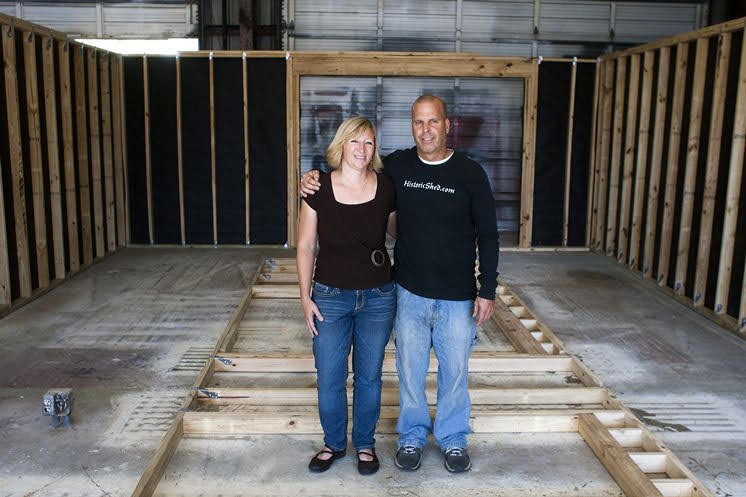
Construction is a hard field to be in during the best of times, but the increased challenges had made it even harder. I still loved to design for new customers, but getting permits seemed to be getting more difficult and took longer. Craig spent hours seeking materials I had specified, but which were not available or had jumped up in price. Then we had to explain to customers that we had to change how things would be built and submit changes to the building department for review, adding further delays. To top it off, Craig had to strap his tool belt on more frequently to replace our missing workers, while also renovating our historic home. We found we were working twice as much for less money.
In short, the last bit of fun was gone for us.
So, we looked at our options. One was to expand and build our units as part of the manufactured building program so we could build less customized, but more units that would be delivered whole to reduce costs and permitting and inspection time. Unfortunately, our 5,000 sf shop space was just not big enough and the cost to expand was cost prohibitive in a time when we still weren't sure we could get the materials we would need. It would also be a huge change to the all-custom niche product line that we were known for.

We considered subletting our shop in part or whole, or finding an easier to build and ship product (Craig had some great custom fence picket ideas), but then we looked at the big picture of what we really wanted to do. We'd bought a couple of residential lots in Brooksville previously and then took a big leap buying a 4-acre parcel of land downtown earlier this year. What we really wanted to do was build traditional homes on these lots using the same design concepts that made our sheds and other outbuildings so popular. We decided that selling the shop would allow us to focus on this goal, so that it what we did.
So, what does this mean for Historic Shed? I think it is easiest to say that the building component of Historic Shed is on extended hiatus now that we don't have a place to build our units in. I don't know if we will resurrect it or pass it on to another builder when things stabilize. The design portion of Historic Shed will continue to be promoted through online sales at Liberty House Plans, as well as taking on custom design drawings occasionally. We also have some ideas for how to use our Historic Shed brand in some alternative ways, so do check back here periodically. And we are open to working with anyone who might want to license our designs for projects or for their own customers (franchise, anyone?).

It's been a phenomenal ride, having launched Historic Shed way back in 2008 at our 1212 Ponce de Leon address. We've met so many incredible people along the way, many who have become fast friends. We are very excited for this next chapter in our professional lives, but also nostalgic. Our kids have grown up hanging around the shop, driving laps in go-carts, occasionally building their own projects, and even grabbing hammers and paintbrushes to build sheds during the early years. We've had puppies and kittens and fallen trees and any number of crises along the way. There has been tears and drama and laughter and stories galore. And we ended our last day with both kids (not so kidlike anymore) helping to load trusses and walls for our few remaining jobs.
Thanks so much for being a part of what I will refer to as "Phase I" of Historic Shed!
AARP created a nice guide to ADUs earlier this year with some case study write-ups. They have followed up with some full length stories of the ADUs featured, including a nice interview with Bertha who had a Starlet built in St. Petersburg by Historic Shed. https://accessorydwellings.org/2019/12/15/berthas-adu-a-tiny-cottage-in-my-sons-backyard/
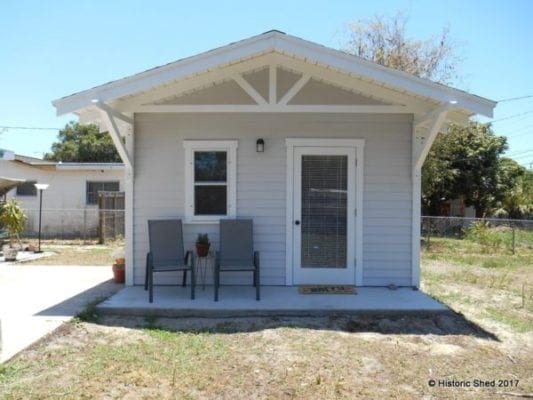
Historic Shed was pleased to be featured in Shed Builder magazine. Read it here: https://shedbuildermag.com/historic-sheds/

Historic Shed was honored to receive a Community Award at the historic Vinoy Renaissance Hotel in St. Petersburg from LocalShops1. https://thegabber.com/localshops1-honors-long-standing-businesses/

We were honored to have a project by Historic Shed included in this informational publication put together by AARP on ADUs (Accessory Dwelling Units): https://www.aarp.org/content/dam/aarp/livable-communities/livable-documents/documents-2019/ADU-guide-web-singles-071619.pdf

More than a few years ago (2011 to be exact), I wrote a post about historic detached carports and included some designs of our own that we thought would be fun to build and useful in a variety of situations. Like many of my random design exercises, none of the sketches were built, until now. And I must say that it looks even better in real life than in my head.
A customer in the oldest city in the US, St. Augustine contacted us and was interested in replacing a rather rickety open garage behind her new-to-her 1920s bungalow. We started with some garage designs, but didn't find the right solution until we dusted off the carport/ shed sketches and found something that fit both the site and the customer's needs.
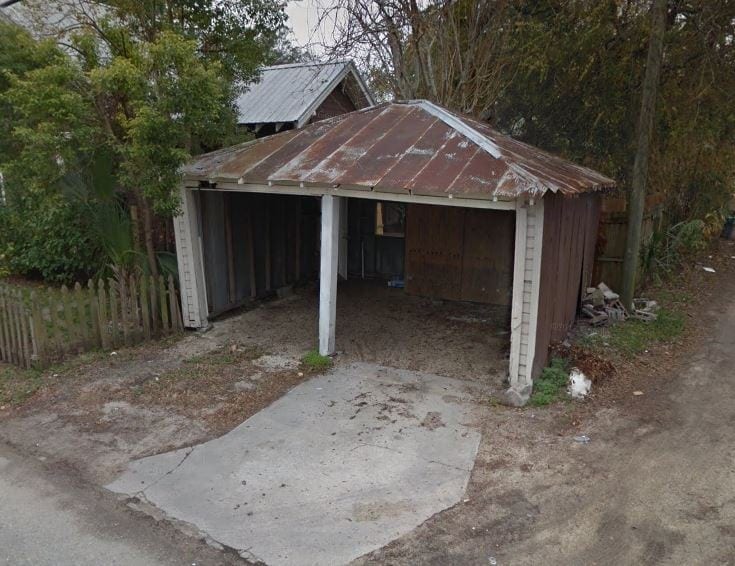

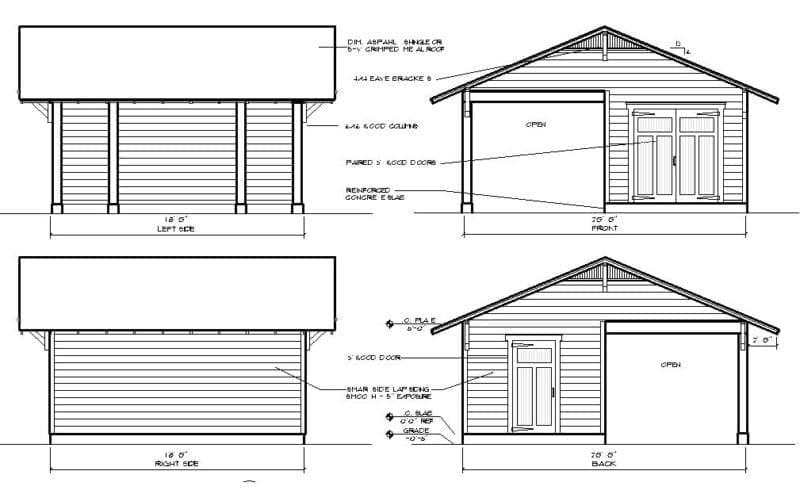


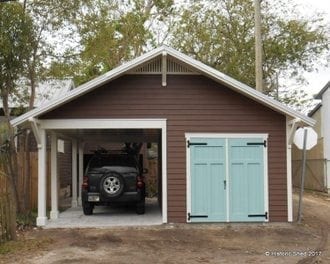

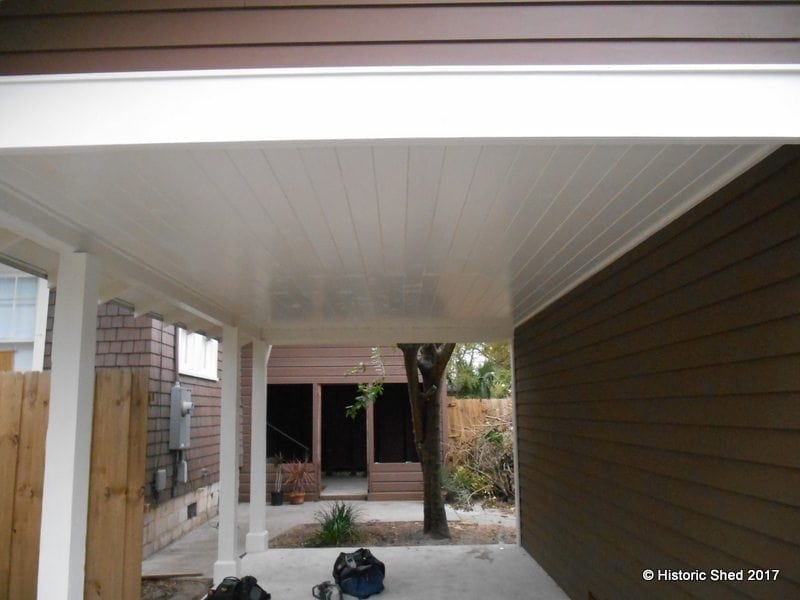
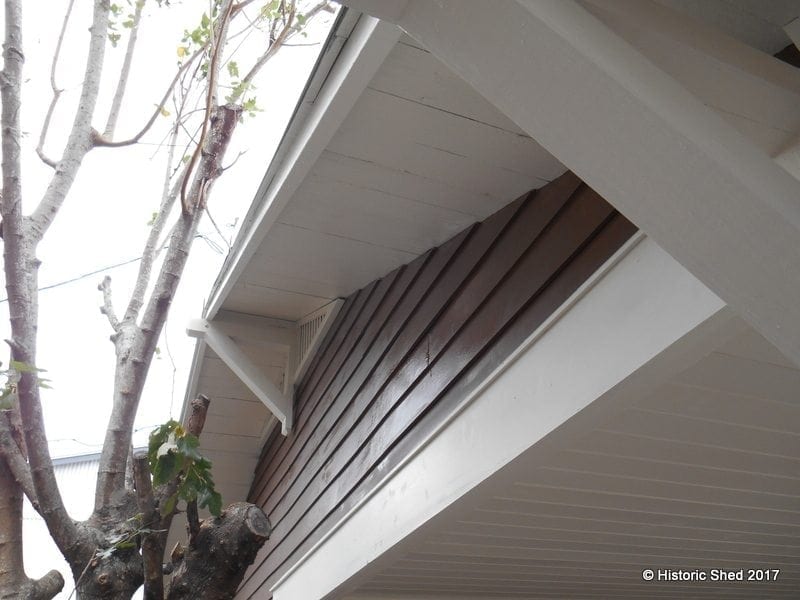
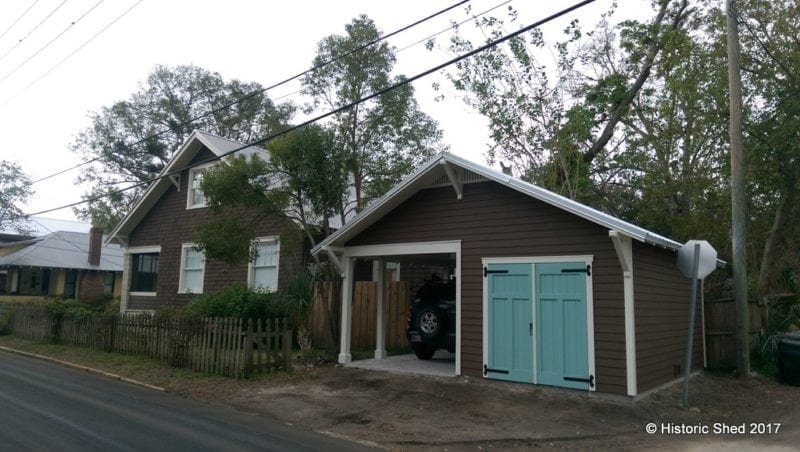
We are now offering plans for the Carport Shed for sale online for the DIYer or those not located in Florida: Carport Shed Construction Plans
We design a lot of custom sheds that complement historic bungalows, but most are commonly covered with lap or novelty siding. Recently we got a chance to built a slightly differently clad shed for a unique 1940s bungalow in New Port Richey. The house, and an existing garage on the lot are both covered completely in wood shingles, so we designed the new shed accordingly.

The cedar shingles made the shop smell so good!

Walls up and roof dried in.
-800x572.jpg)
The shed is designed for use as a workshop with a small door for every day use and a large one for bigger items. The windows on the side are double-hung, meaning that the top slides down and the bottom slides up.

The front gable elevation has a vent that matches the main house.
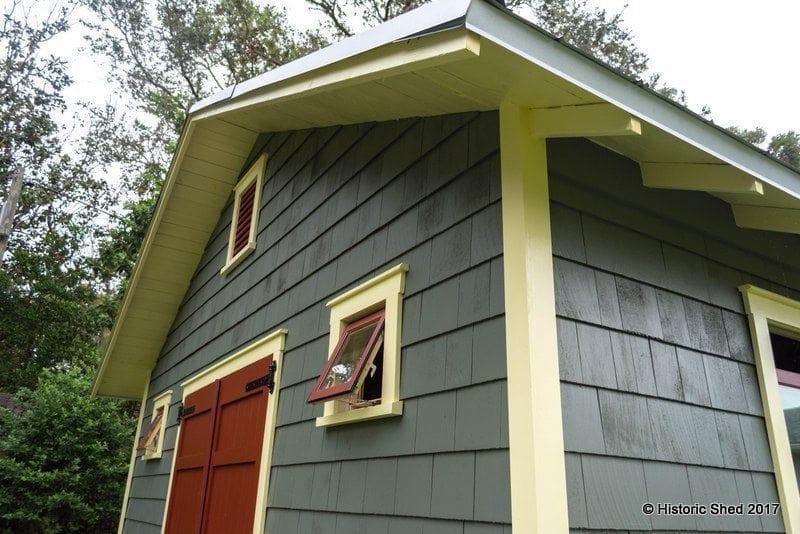
Shed details showing 1x6 roof sheathing, cedar shingle siding, awning windows and traditional trim.
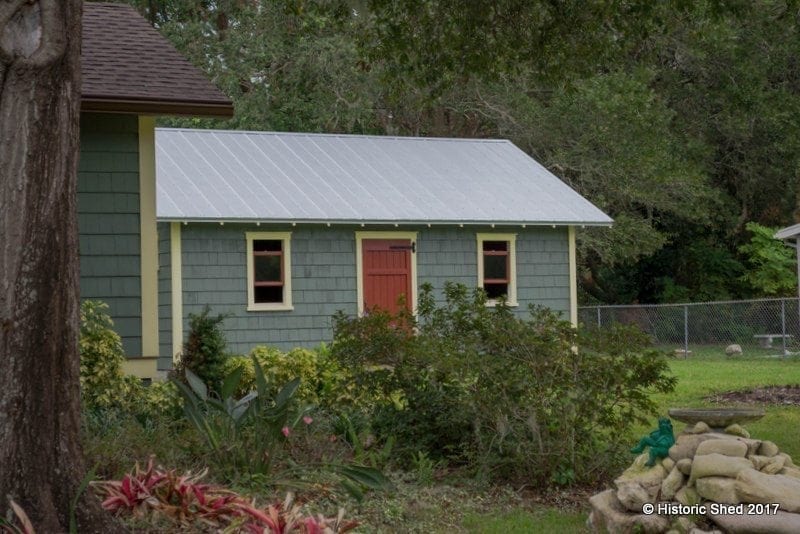
The shed nestled in the yard.
Last fall we were approached by a woman who was interested in building a cottage in her son's back yard in St. Petersburg. We looked through the local zoning regulations and found that the property allowed for Accessory Living Units (ALUs), but not Accessory Dwelling Units (ADUs). The difference between the two in St. Petersburg zoning was that she could build a cottage, but would not be allowed to have a full kitchen with an oven. Other areas of St. Petersburg, mostly in the historic neighborhoods closer to downtown, do allow full cottages with full kitchens (ADUs).
When considering a secondary dwelling behind an existing home (carriage house, in law suite, granny pod, guest cottage, rental cottage, etc.), always check local zoning regulations first as it will tell you if you can build an accessory dwelling unit, if it can have a kitchen, where it can placed (setbacks), and if there are any size limitations. Most communities have their zoning regulations available online at: https://library.municode.com/fl and offer a myriad of information on what can be built where.
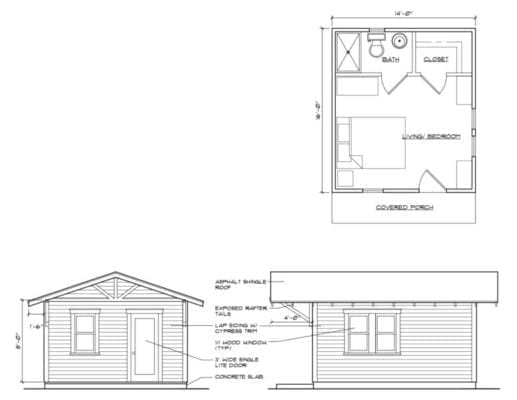
For this project, we adapted our 14'x16' Starlet Cottage plan for our customer's use, turning the kitchenette area into a walk-in closet and adding a roof extension over the front door to create a porch seating area. The end result is a comfortable and nicely appointed cottage. See details here, although the closet and bath ultimately were reversed: Starlet Cottage Plan In addition to meeting the zoning requirements, the cottage meets all Florida Building Codes and is legal for full time living.
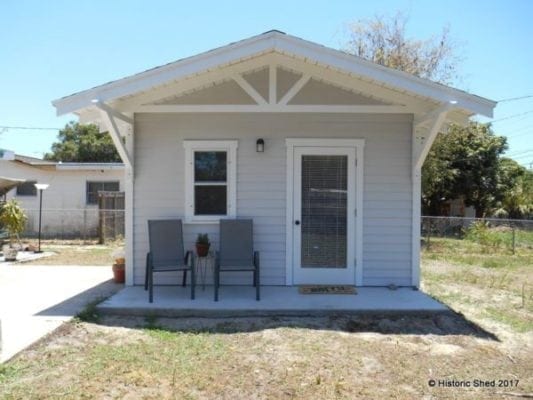
The front gable roof was extended to 4' to create a covered seating area.
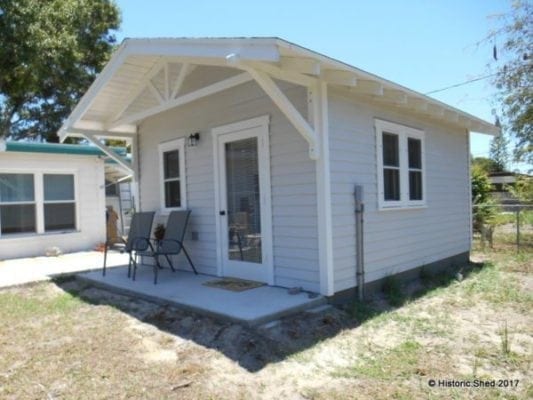
The 224 sf cottage is set on a concrete slab so she wouldn't have to deal with stairs.
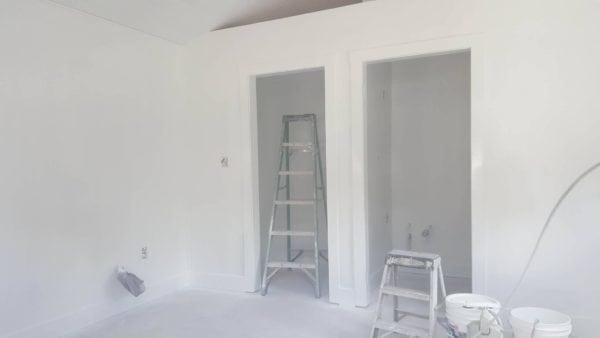
The cottage interior under construction - bath on the right, closet on the left, storage loft above.

The front area of the cottage is an open room with cathedral ceiling and a storage shelf along the top of the wall.
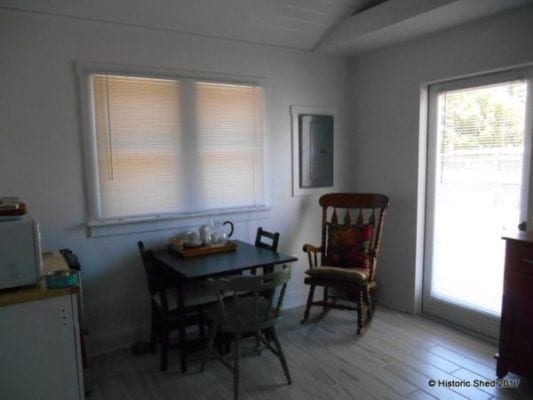
A small seating area fits nicely along the side wall. The flooring is ceramic tile with a weathered wood look.

While the cottage was not allowed a stove/ oven, there is room for a small refrigerator and microwave.

The bath meets Florida Building Code requirements and includes a nice sized shower. A tankless water heater is located in the adjacent closet.

The cottage was designed with a windowless wall so that the owner could install this lovely Tuscany scene.

Once the landscaping goes in, this custom Starlet Cottage will be quite pleasant.
Historic Shed now offer the Starlet Cottage as a shell-only package with all required architectural plans: https://historicshed.com/cottage-packages/
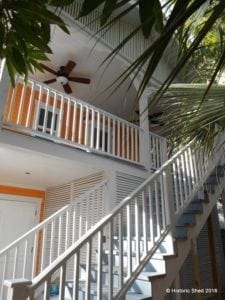
Several years ago I was contacted by a woman who was in the process of buying a house in the historic Gillespie Park neighborhood in Sarasota. The 1920s house came with a detached garage in not-so-great shape, placed awkwardly in the middle of the yard and she wanted to replace it. Then she had a few big life changes, including moving out of the country, and the plans for the garage were put on hold. When she called back last year, she no longer wanted to just replace the garage. Instead, since the main house was being used as a vacation rental, they wanted to add a garage apartment that could also be rented out. Historic Shed™ designed a two-story, two car garage apartment with details that complemented the main house with a one bedroom, one bath layout. We also included a large porch for a private sitting area for visitors, accessed by an exterior stair. The cottage is available for rent at: https://www.vrbo.com/811457 So far, it has some rave reviews.
One of the perks of being in the preservation business is seeing all sorts of great historic sites that aren't always available to the public. When we worked primarily as historic preservation consultants under our Preservation Resource, Inc. mantle, we got to crawl in attics and private rooms of house museums, disused hotels, and even airplane hangers. Now, as we focus on making outbuildings for historic neighborhoods, we get to see private homes that aren't open to the public (I never say no when invited inside for a moment). One of the recent highlights was seeing a high-style Craftsman style bungalow in the Old Northeast neighborhood in St. Petersburg that was under rehabilitation.

The house has heavy timber framing details, great clinker brick porch piers, wide eaves and long, low lines.
Known as the Sargent House, 806 18th Avenue NE was recently designated as a historic landmark by its newest owners, Sharon Winters and Kendall Reid. Originally built in 1923 by LeRoy and Marjorie Sargent, the house is significant for its architecture as a rare example of higher-style Craftsman design and construction in the airplane bungalow type. (See the full report at: http://www.stpete.org/committee%20packets/Community%20Planning%20and%20Preservation%20Commission/2016-04-12%20Reports.pdf). A local landmark designation recognizes structures or places that have historic value or that exemplify cultural, economic, or social value to the city, state, or nation. The benefits of this designation include neighborhood stabilization, increased heritage tourism through the maintenance of our historic character, relief from some of the requirements of the Florida Building Code, and an ad valorem tax exemption.
Historic Shed was hired to design and build a small storage shed to be placed behind the house. The simple shed incorporated elements from the house such as the gable detailing, roof pitch, and outrigger design.

The shed is located within a flood zone and has flood vents along the back and alley side.

The roof outriggers are prominent on the main house. The shed has scaled down versions to visually complement the main house. The gable vents are also geometrically similar.

While the main house is covered in shingles, the shed uses cypress siding. The doors reflect the Craftsman design of the main house.

The shed nestled behind the main house
Some home details are just so lovely they just have to be replicated. For this 10'x12' shed that Historic Shed built in the historic Duckpond Neighborhood in Gainesville, Florida, the eave brackets and unique gable vents were replicated to create a one of a kind shed. The result is a main house and shed that harmonize very well. The shed design was reviewed and approved by the local historic preservation office.
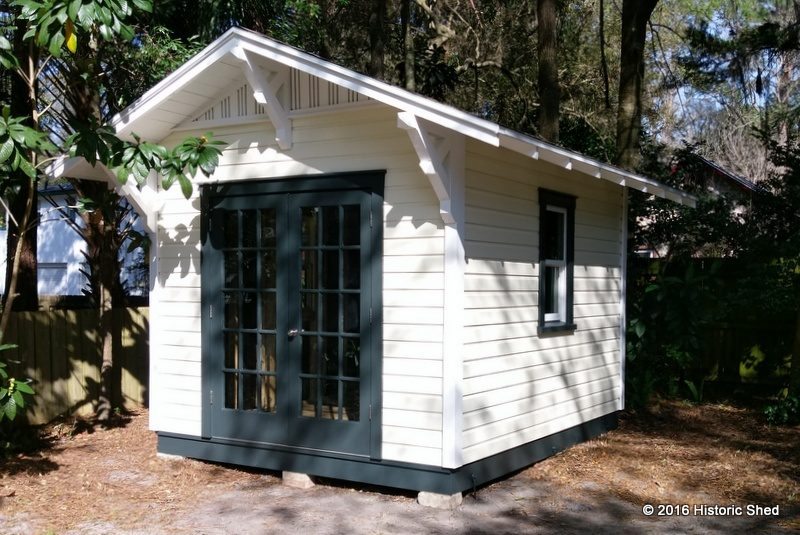
10'x12' custom shed with French doors and interesting eave brackets
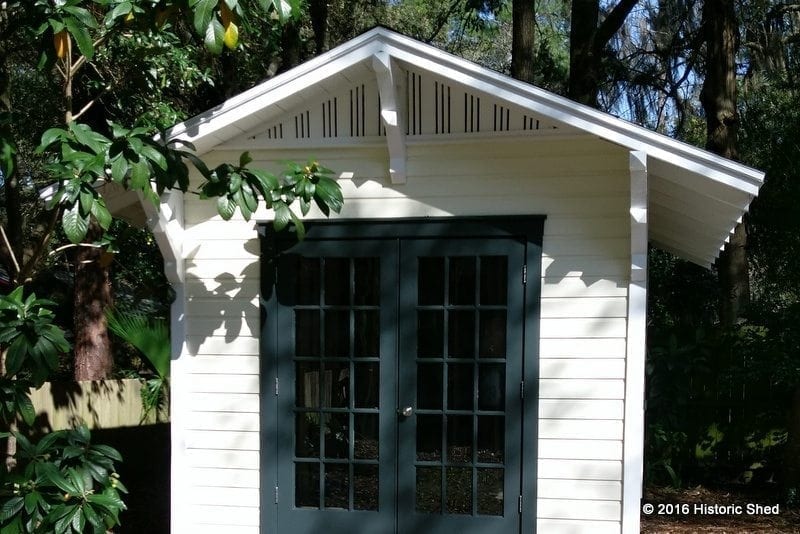
Shed vent detail complements the main house
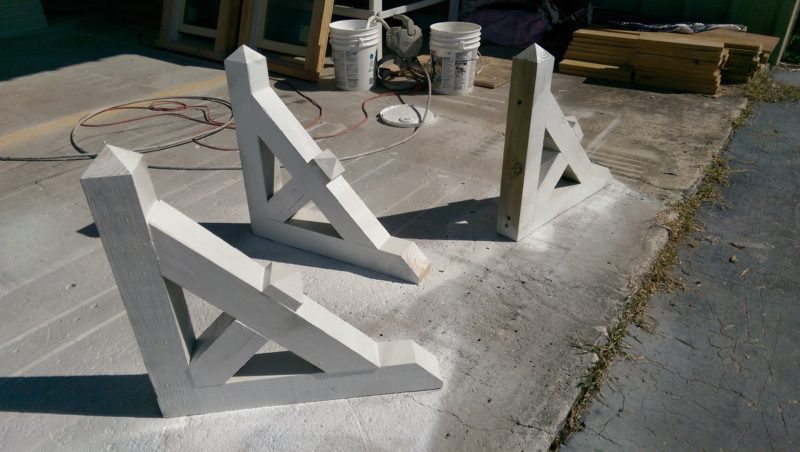
Craftsman eave brackets being prepped for for a Historic Shed storage shed

Historic Shed installation
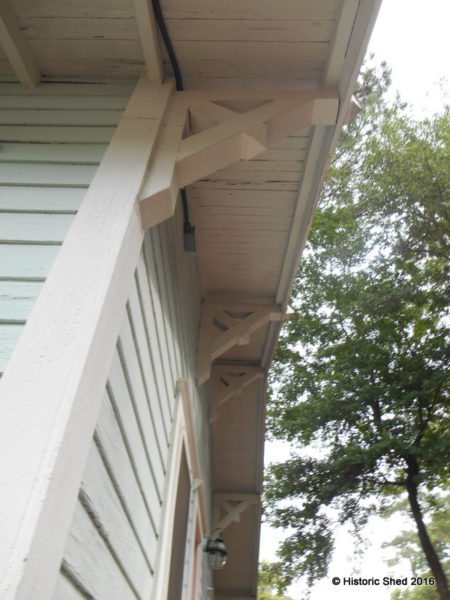
The original Craftsman bracket detail on the historic Duckpond house

The existing gable vent on the historic home - note the different outrigger detail on this side of the house
Every time we are approached by an artist in need of a studio, we end up with a unique shed design that is worthy of showing off. In this case, a local artist in Citrus County requested a fairly large 14'x16' shed with lots of windows. The design has great balance, is filled with light and looks lovely with a great set of accent French doors. It will serve as a great "She Shed" for the owner.

This clasic shed is accented nicely with a fun colored set of French doors.
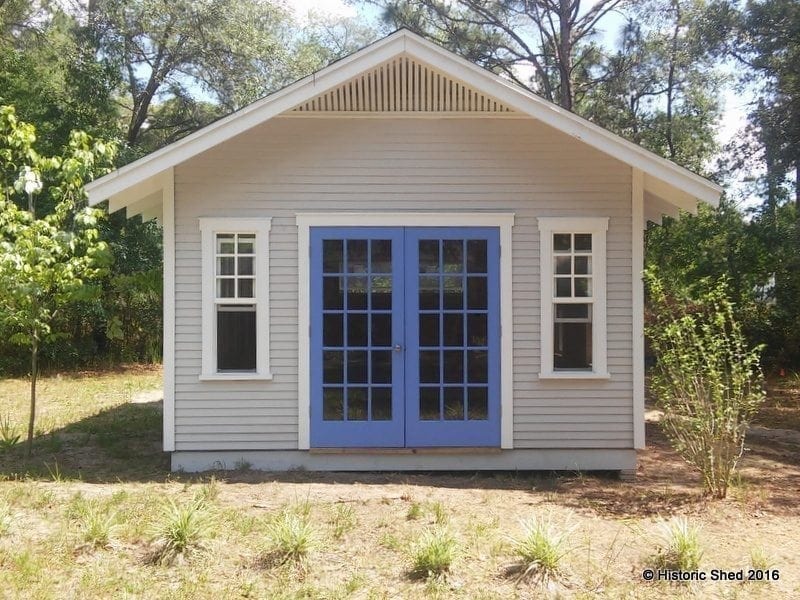
The front elevation has nice symmetry.

The shed has a nice bank of three windows on the left side.
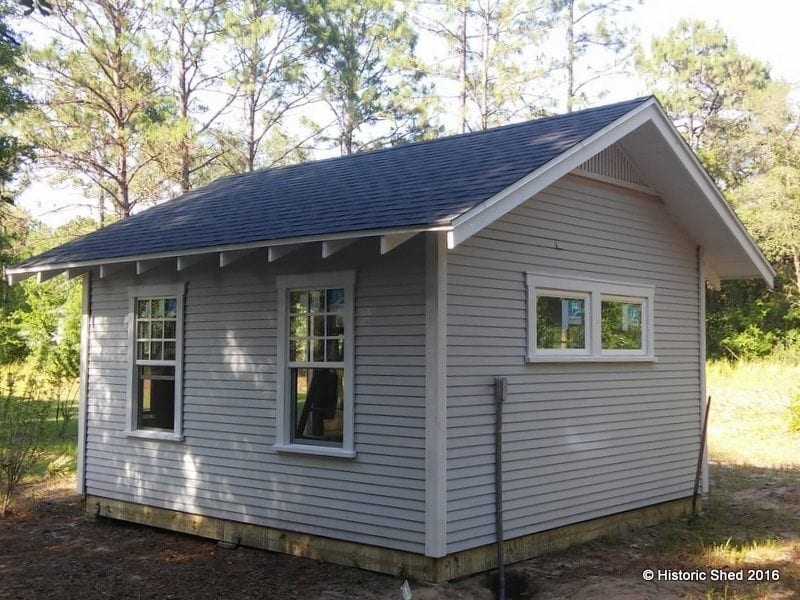
The rear of the shed has two operable transom windows, allowing light, but also wall space inside.

Retractable screen doors were installed behind the French doors to give protection from bugs but not taking up interior floor space.
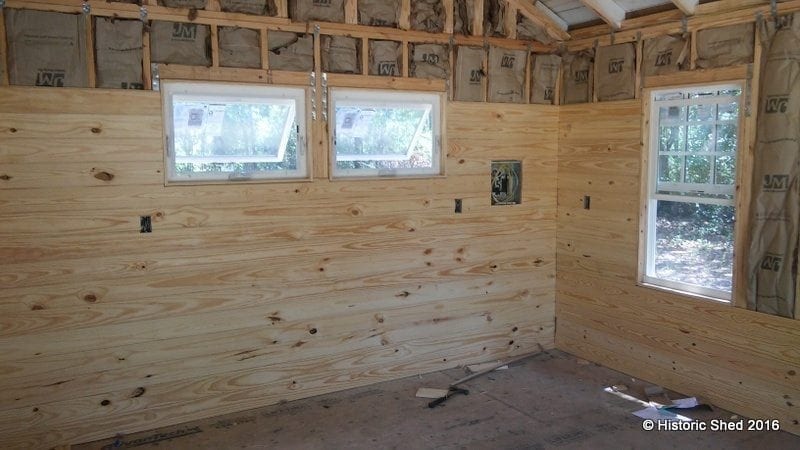
The interior walls were insulated and tongue and groove pine installed.

The finished interior has exposed roof framing with board sheathing and pine T & G walls with simple trim.
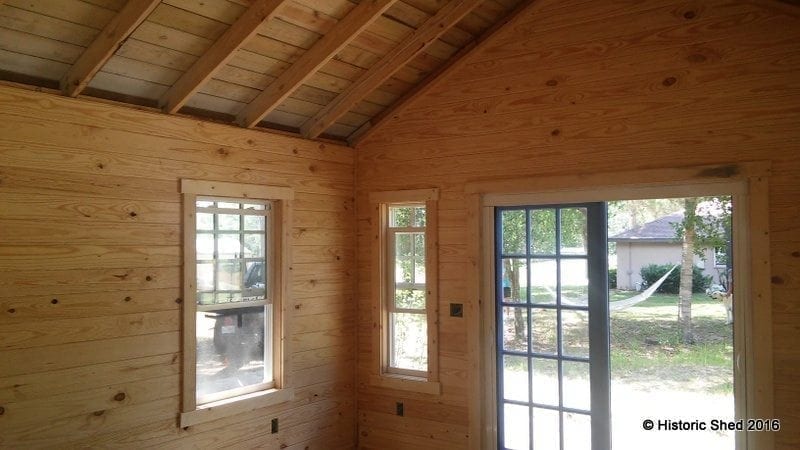
The finished interior looking out.
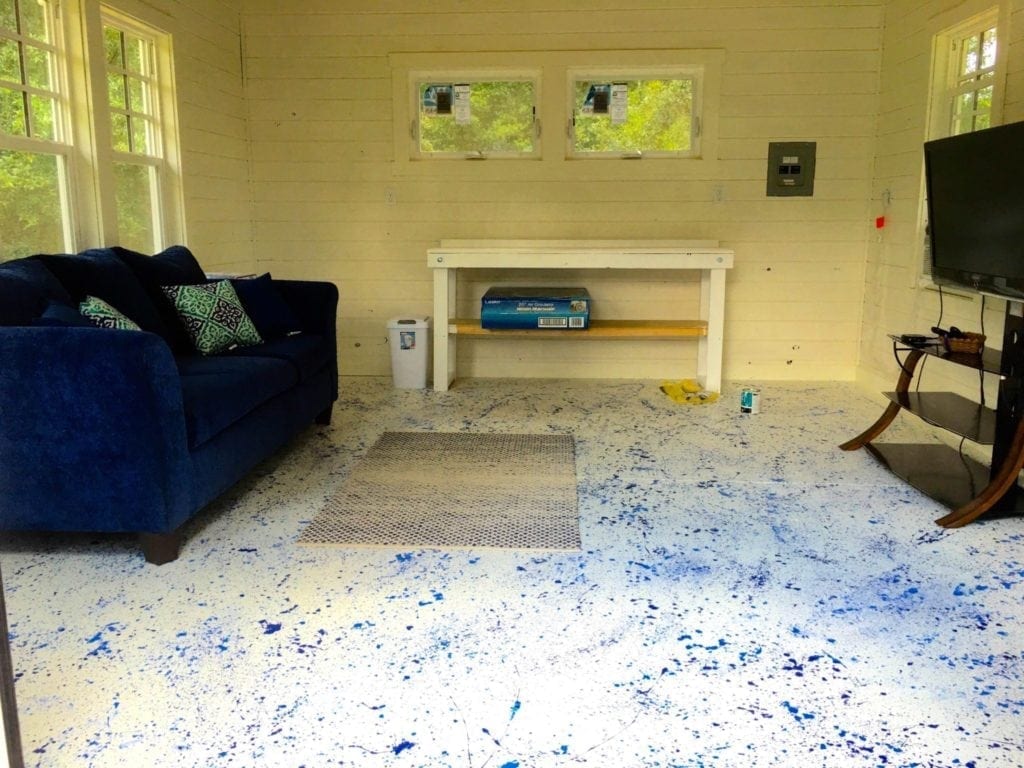
The interior after some fun creative moments - photo courtesy the Owner.

Ready to move in - photo courtesy the Owner.
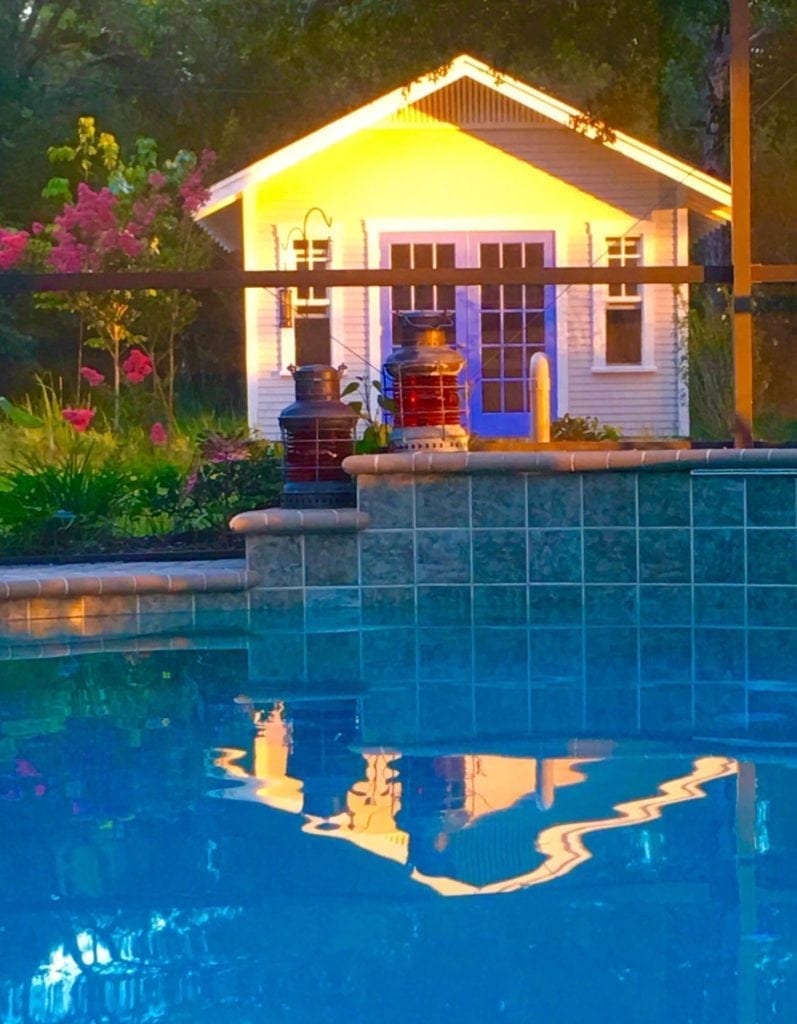
And a beautiful view of the shed in the yard, courtesy the Owner.
Last summer we built a shed in the historic Village of Longboat on Longboat Key, which was the talk of the neighborhood according to our customers. The home where the shed was built is the oldest building on the island, built in 1902 and was originally an Inn and Restaurant. The shed we built for them used elements of the main building, including novelty wood siding and a metal roof. It was the first one we built with a transom over the shed doors, which turned out to be a really nice architectural feature.
The shed was set to the rear of the main building, along the side yard with access to the rear alley. It was set far enough from the side property line to allow storage of kayaks and other equipment, so the owners had the concrete pad extended to the side.
The shed had a very steep roof, gable vent that complemented the main house, and a double set of doors that faced the rear alley.
The side of the shed has a central doors flanked by two 6/1 windows. There are also flood vents since the area is located in a flood zone.
About 9 months after completing the shed, we were contacted by a neighbor in Longboat Key who also lived in a historic home. His home was originally the one-room school house for the village, which had been transformed into a residence in the 1950s. He liked the neighbor's shed just the way it was, so asked for something similar, using elements that complemented his home.
The Village of Longboat Key has an interesting history and is worth a walk around if you are heading to the beach in that area (which is definitely worth visiting as well). For a walking tour, see: http://www.longboatkeyhistory.com/tour-route--history.html and http://www.longboatkeyhistory.com/map--details-of-tour-route.html. As you walk around, keep an eye out for the roaming peacocks, which add a nice eccentric touch to the area.
We've been advertisers in Hyde Park Living and Palma Ceia Living magazines (really nice full-sized glossy magazines) since they were first published a few years ago, as these are two of our favorite south Tampa neighborhoods. When I mentioned a recent project to the magazine director, Bradley Hassen, she very nicely offered to do a feature article in the magazines. The project highlighted is a two-story garage-apartment recently built in the Historic Hyde Park neighborhood. The article appears in the February issue of Hyde Park Living and will also be in the March issue of Palma Ceia Living. The magazines are mailed to residents of each neighborhood. Click on the link below to see the article in better detail.
Historic Shed was contacted by a couple who live in the Hyde Park historic district in Tampa to design a garage and guest room for a very unusual lot. Triangular in shape, their small lot was just over 4,500 sf and contained a lovely one-story Craftsman bungalow with less than 1,000 sf. The atypical lot was further constrained by a large protected oak tree on the site, and one on a neighbor's lot, just over the property line. With Tampa's strong tree protection ordinances, this left little space to build. Building up was the only real option to maximize the remaining lot space.

Before: The site once had a one-story one-car garage on the lot, long since gone. The original concrete was still in place, complete with a 1919 date embossed. A ramshackle carport had been constructed by a previous owner.

The Main House: The historic bungalow on the site has a 3:12 roof pitch and 4' bead board eaves with bracket supports.
After tweaking the design to fit the lot and meeting with Tampa's Historic Preservation Office and Forestry Department, the resulting project created a 12'x20' one-car garage with apartment above. A 6'x8' one-story shed allowed additional storage while accommodating the lot's shape and giving a visual step down from the two-story volume to the street. The stairs were placed at the rear of the building for privacy with an exterior design that allowed them to encroach within the required oak tree setback.

Due to height constraints at the Historic Shed shop, the first and second floors were prefabricated separately.

Installation of the Garage Apartment adjacent to the historic Hyde Park bungalow.

Trusses installed, roof sheathing on, and the shed addition in place on the right side.
The garage design itself took its cues from the main house which had a low-sloped front-gable roof and very wide eaves. Walls were clad in lap siding and an existing skirt board was inspiration for a belt course on the new building. The new outbuilding was kept simpler in architectural detail, but clearly complementing the main residence.

Windows and shed door installed. With no alley and an odd shaped lot, the garage faces the street and has the same front setback as the main house.

The stairs to the second floor apartment are set to the rear of the building for privacy. The exterior wood framed stairs allowed the building to set closer to the protected tree on the site.

Second floor interior view when you walk in the door. The floors are laminate, the ceiling is 1x6 V-groove pine, and the walls are drywall. A mini split ac system cools and heats the space.

The main room in the second floor apartment. The space will double as a home office and guest suite.

The French doors let in extra light. A 5'-6"x5'-6" 3/4 bath is located on the right.

View into the apartment bathroom.

The Garage Apartment Floor Plans

A steel overhead garage door with a carriage house overlay by CHI finishes out the front facade along with period-inspired lighting.

The ribbon driveway completes the exterior of the garage apartment with a period look.

The interior of the garage was finished in plywood fro added strength. The storage shed is located on the right.

The 6'x8' side storage shed features a cypress bead board door.

Details on the Garage Apartment front facade

Eave and trim details on the garage apartment

The finished product, waiting for sod.

A new deck creates a welcoming entry from the street.
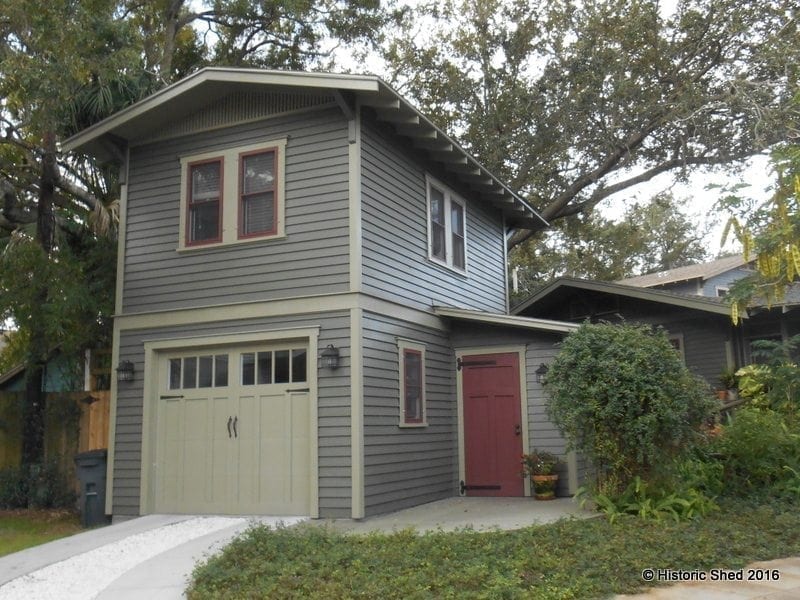
Landscaping completes the look.

And the rear of the carriage house completed.
See more about the Two-story Garage-apartment options. A two-car version is in the works as well.